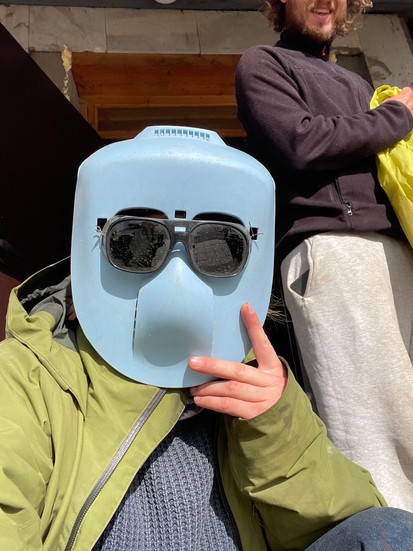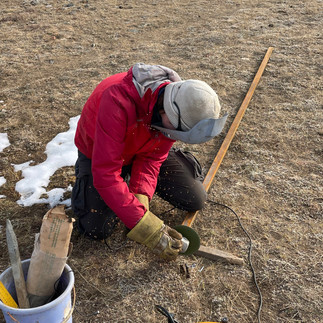Mongolian Farmers are Casual Engineers
- stemeillon
- Oct 28, 2024
- 5 min read
After two months in Mongolia, the engineer in me cannot help but notice all the ways Mongolians think like an engineer, starting with “at-home engineering,” a concept wherein people make often simple alterations to everyday objects to fix them or make them better for themselves (you can see examples at engineeringathome.org). It’s awesome to see the solutions they come up with; here are some of the examples I've seen or helped with:
In the winter, it’s common for it to be -40 degrees and the car engines freeze over, unable to start. Since most do not have a garage, they sometimes light a small wood fire underneath the car to heat the engine and start it. For me that's unthinkable, but for them it's the most logical solution to their problem.
Their cooking pots, called Togoo or Khazan in the west, are quite versatile and are sometimes turned over to create an oven over the fire instead of using it as a pot. Also, the handle to the lid on the pot we use broke, so we tried to glue it back. It kept falling off, so Minjee hammered a nail through the lid to grab at instead.
Alta fixes all his own farm equipment, figuring out which parts to order and sometimes enlisting the help of a friend. We were fixing their digger machine and the cord ripped out, which I fixed before but it took me forever. Alta did it in about five minutes.
I helped our guide fix the light switch at the nomadic family’s ger we stayed at on our horse trek. It had clearly already been fixed a few times before, and we used our teeth to strip the wire and then just tied it in a knot around the terminals of the battery. It seems to me that many Mongolians have a basic understanding of electricity that allows them to at least fix the breakers in their houses and connect a solar panel to a battery.
When we were branding horses, I was pushing a wheelbarrow full of fire for the branding iron and the fire was coming straight at me and my wool sweater, so I was going pretty slowly. Minjee huffed at me, saying that I was too smart to be so dumb, and pulled the wheelbarrow instead so that all the flames were going away from her.
The water pump was broken, so Minjee's sister-in-law came over, stuck her hand in the pipe, pulled out a few nuts and screws, and it started to work. I have no idea why.

When a man was driving me to start my trek, the middle console blew open and I couldn’t close it again. He rolled up a little piece of paper and jammed it in the middle, and for a reason I couldn’t see, that fixed the issue.
At a horse-racing competition, they didn't have a generator so they used the car battery to power their loudspeaker.

The yurts are a remarkable engineering feat that use zero fasteners. They use pieces of chord or horsehair (“oos”) to tie the pieces together, building an amazing relationship of tension and compression between each element. Once they’re built, it would be practically impossible to knock over. They also use the space between the poles and the fabric to tuck things, making it kind of like a hook.
Their toilets, while sometimes terrifying, are always highly functional. Sometimes the flushing mechanism doesn’t exist and there is just a handle on the water valve that you quickly turn on and off. Other times, the tank cover is removed and you can pull the chain in the toilet directly. Regardless, you can never flush toilet paper and instead put it in a bin provided. Most often, though, there is no toilet, just a hole with two pieces of wood straddled across it where you put your feet, and you squat and either throw the toilet paper in directly or put it in a separate pile.

The traditional Mongolian wear, called a deel, is kind of a real-life Thneed. They use it in the house to stay warm, as a blanket, as a table. They can wear it horseback riding, or hunting, or on a motorbike, or on a regular bicycle. It wraps around the legs to keep them warm but is not so long that it hinders mobility. The belt they tie around the middle is not only fashionable, it allows them to use the top part of the deel as a giant pocket. Also, it’s essential for protecting their internal organs and lower back while they ride horses, effectively keeping their insides in place.

We went to go pick up a handheld welding machine from a friend, who looked like a mad mechanic from a steam punk movie. He pulled it out of the car and the exposed wires ripped off, so he ran off to get a set of pliers and some tape and taped it back together, unconvincingly I might add… The welding machine itself looked ancient and terrifying compared to what I learned on in school, but he showed us and it did work just fine(ish). Also their welding masks are terrifying looking.
When we built a deck for Minjee, we quickly learned that the Mongolian construction standards are not so well established. When you order materials, often they come in the wrong sizes. But that’s just how it works! People do not go back for a refund or to replace the parts for the right ones, likely because the amount of work required to do so is more hassle than just changing your construction plan. Many of their parts are recycled or reused as many times as possible, so we built the deck foundation from old railway sleepers and cinderblocks and nailed them together with giant ties. Initially I Googled “how to build a floating deck on a hill” and the pictures I saw of peoples’ beautiful new and shiny foundations made ours look like a big joke.
Similarly, we are cutting and welding a fence for the calligraphy center in Kharkhorin, and all the metal came in the wrong sizes. We re-cut everything, and Tamir handed us a metal saw and the old welding machine and told us to have at it with no guidance. He told us he had no idea how to do it, and explained that Mongolians just figure things out as they come up. With Tamir I also tiled a bathroom, installed a toilet, rigged the plumbing, and tended to an absurd coal oven that will probably give me cancer. All of these things are self taught for Tamir, who hated school and is a master caligraphist. Some of it works great and sometimes it doesn’t at all, but he figures out a way to fix it (ish) every time. Lots of things work, ish, here.
Mongolians may not know how everything works right away, and they do not usually have instruction manuals or the like, but they are quick to understand how something functions and are good at figuring it out through YouTube/Google if they can’t get it by themselves. They are resourceful and creative, and I feel like I’m learning more about hands-on engineering and trade skills than I did in most of my classes because here you must really understand the fundamentals of why something works, not just a formula or instruction manual.




























































Komentarze